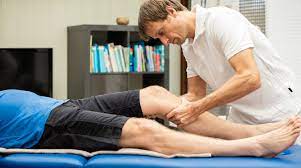What to Expect After a Fractured Femur?

A fractured femur or thigh bone is a significant injury requiring immediate medical attention. The femur is known for being one of the strongest bones in the body, so it takes a severe event to cause a break or fracture, like a car crash or motorcycle accident. Following a fractured femur, treatment usually includes setting and immobilizing the leg, although surgery can be required in severe cases.
Symptoms
When you fracture your femur, you will feel significant pain immediately. You will also most likely be unable to put weight on the injured leg, and the leg may appear crooked or shorter than the uninjured leg. Other symptoms are swelling, bruising, and in very severe cases, pieces of your femur bone pierce through your skin, causing bleeding, called an open fracture.
Diagnosis
A broken femur is diagnosed after a physical examination, followed by an X-ray or even a CT (computed tomography) scan if necessary. Your doctor uses these imaging tests to pinpoint the exact location of the fracture and determine what type of break has occurred. The type of fracture you have suffered will directly affect which kind of treatment will be best.

Treatment
Due to the femur being such a strong bone, a femur fracture is a rare injury. Treatment can vary based on the location and type of break but may include setting the leg, immobilization with a cast or splint, and pain medications. If there is a displaced fracture, your bones may need realignment before casting. Depending on the severity of displacement, surgery may be required to manipulate the bones back into position. If the fracture is severe or there is more than one, you may need external fixation, which uses an outer metal rod and pins to hold the bone or bones in place until they are properly healed. Internal fixation devices like plates, rods, or screws may also be used to sustain the correct position of the femur for healing. Physical therapy is recommended during the healing phase to restore muscle strength, flexibility, and range of motion. A full recovery from a fractured femur generally takes about four to six weeks.
Summary
Unfortunately, a fractured femur will usually significantly impact your life, but only temporarily. Surgical and nonsurgical treatment methods are routinely effective, and people typically can make a full recovery after a femur fracture.
Featured Clinician: Anthony Maritato, PT
FEATURED CLINICIAN: Anthony Maritato, PT Anthony Maritato, PT, MSPT, is a licensed physical therapist and co-founder of Total Therapy Solutions, a private practice outpatient physical therapy business that focuses on
Colleen Rapp Wins Friend of Private Practice Award
Long time patient advocate, Colleen Rapp, was awarded the APTA Private Practice Section’s Friend of Private Practice Award during the 2022 PPS conference. Colleen has long been standing up for
Top Tips for Relieving Nerve Pain
Top Tips for Relieving Nerve Pain If you suffer from nerve or neuropathic pain, then you can certainly attest to how it can throw a wrench in your day-to-day routine.
How Your Diet Can Cause Inflammation
How Your Diet Can Cause Inflammation Depending on the situation, inflammation can be a good thing or a bad thing. It is good in that it is your body’s way
What to Avoid After Knee Replacement Surgery
What to Avoid After Knee Replacement Surgery Knee arthroplasty, otherwise known as knee replacement surgery, is designed to relieve pain and restore function in severely diseased knee joints. No matter
How Physical Therapy Can Help You Avoid Reliance on Pain Medications
How Physical Therapy Can Help You Avoid Reliance on Pain Medications If you suffer from chronic pain, you know how managing pain can be a real challenge. Another day, another
Kyle Yancey
Latest posts by Kyle Yancey (see all)
- Top Tips for Relieving Nerve Pain - October 28, 2022
- How Your Diet Can Cause Inflammation - October 25, 2022
- What to Avoid After Knee Replacement Surgery - October 19, 2022
- How Physical Therapy Can Help You Avoid Reliance on Pain Medications - October 13, 2022
- Physical Therapy for Heart Disease - October 11, 2022
